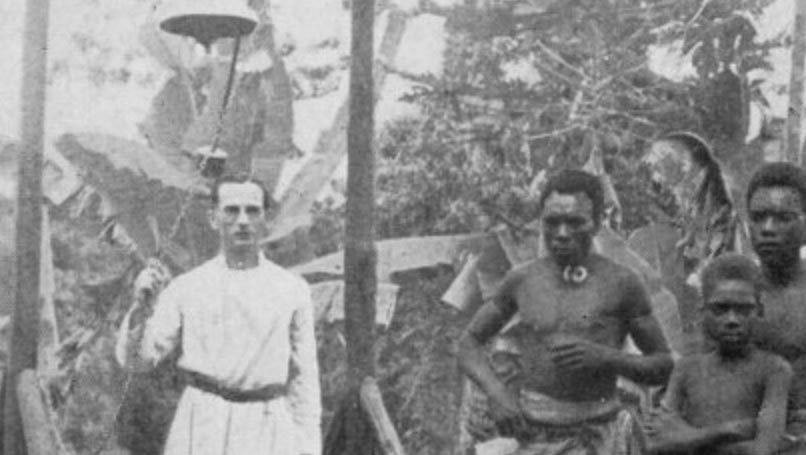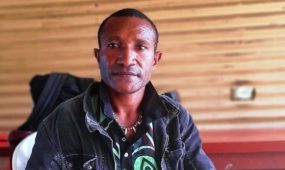New Guinea Martyr: The Rev’d John Barge
Features
“As a student at St Francis Theological College, and as a new priest engaged in Curacy at St James’, given responsibility for the daughter church of St Thomas’, North Toowoomba, The Rev’d Barge was remembered by many in our Diocese,” says Archives Researcher, Adrian Gibb

On 2 September this year, as we do annually, our Diocese will pause to remember the 12 men and women known collectively as the ‘Martyrs of New Guinea’. While many of those in this courageous group had strong links to our Diocese, for St James’, Toowoomba, it is The Rev’d John Barge whom they particularly remember. As a student at St Francis Theological College, and as a new priest engaged in Curacy at St James’, given responsibility for the daughter church of St Thomas’, North Toowoomba, The Rev’d Barge was remembered by many in our Diocese.

The Rev’d John Barge, c.1935 (Image from St. James’ Toowoomba Celebrates 140 Years by Lyn Hodgson, 2009, p.45)
John Frederick Barge was born in Buckinghamshire, England, in 1897. He served with British Forces in Belgium during the First World War. He came to Australia in 1926, initially engaged in fruit picking at Stanthorpe. By 1928, however, he had become an honorary Catechist with the Church Mission in Brisbane and in 1929 he began studies at St Francis Theological College. He is said to have been a diligent student, and one willing to help new pupils when they came to the College.
Advertisement
One such pupil was The Rev’d H.E. Hunt. In the book St. James’ Toowoomba Celebrates 140 Years (2009), edited by Lyn Hodgson, it is stated that The Rev’d Hunt, who became Rector of St James’ in 1948, had been taken under John Barge’s wing and was shown great kindness by him when he first entered St Francis Theological College. They became firm friends and were ordained on the same day in 1933 by Bishop Dixon at the Cathedral. The Rev’d Hunt even composed a poem in memory of his friend, produced in the history of St James’ book:
In Memory of John Barge
Cheerful and brave and true,
The Martyr’s path he took,
Man’s daily human needs he knew,
Also man’s need of God
To palm fringed Islands far,
He took the news of Christ,
And following the Wise Men’s star,
His life he sacrificed
Yet still his spirit lives,
And all his kindly ways,
And where God’s sun its Glory gives,
He still shows forth Christ’s praise.

The students and teaching staff at St Francis Theological College in 1930: John Barge can be seen at the far right of the back row (Image courtesy of the Records and Archives Centre, Anglican Church Southern Queensland)

Students at St Francis Theological College in 1932: John Barge is seated second from the left in the front row (Image courtesy of the Records and Archives Centre, Anglican Church Southern Queensland)
Barge’s curacy at St James’, Toowoomba began on 18 December 1932. As mentioned, he was given responsibility for St Thomas’ Church in North Toowoomba. He established a firm affection with his parishioners in a very quick fashion. He established the Ladies’ Guild and revived the Sunday School, as well as establishing other groups and encouraging improvements to the building and grounds. According to the parish history, he had a fine tenor voice and rode his bicycle everywhere until he could afford a second-hand car. However, his calling was elsewhere, and on 1 September 1936, a farewell service was held for The Rev’d Barge as he embarked on overseas missionary work.
Advertisement
The Rev’d Barge first went to Rabaul, New Britain, one of the New Guinea islands. While engaged in mission work there, he began to realise an overwhelming desire to help locals relieve their physical pain and suffering, as well as tend to their spiritual needs. So, he decided to embark on training in the Solomon Islands for the treatments of various tropical complaints and spent some time stationed at a medical centre. He was also, for two years, from 1937 until the beginning of the war, the Vice-Principal of the Theological College of St Peter in the Solomon Islands.

The Rev’d John Barge with locals on the island of New Britain, c.1937 (Image courtesy of anglicanhistory.org)
At the outbreak of the war, John Barge was back in New Britain and working with The Rev’d Bernard Moore, another New Guinea Martyr, and a group of Melanesian Brothers. After the bombing of Pearl Harbour many of the Melanesian Islands were occupied by advancing Japanese forces. In anticipation of this, both Barge and Moore were given the opportunity to leave; however, they both declined, preferring to stay at their posts. During these anxious times, the local Islanders took The Rev’d Barge to a cave where they believed he could hide if, and when, the Japanese forces invaded. It was a very snug space, needing Barge to crawl to get inside, and he is said to have remarked to the well-meaning islanders that he would rather die on his feet than as a rat in a hole.

Map showing the island of New Britain, with Rabaul located top right (Image courtesy of anglicanhistory.org)
As the location where The Rev’d Barge was stationed, Pomete on New Britain, was very remote, he was able to carry on his duties in secret for almost two years after the Japanese forces had taken over the Island. The local people kept his presence unknown and at no point gave up his position. The occupying forces regularly sent out search parties to look for Allied forces or people being hidden by locals, and on one of these searches, in October 1943, the mission house at Pomete was discovered. A Japanese Destroyer approached, and troops were sent into the area where they found The Rev’d Barge carrying on his duties as normal. In the book, The Seed of the Church: The story of the Anglican Martyrs of Papua New Guinea, the author Errol Hodge describes what happened next:
“The Japanese, who seemed friendly, took him aboard the destroyer, telling the local people they would help him get medical supplies and bring him back. But after the ship had rounded the next point, he was taken ashore. Two local people hiding in the bush saw him executed ‘with shot and sword’ (1992, p.24).”
Because of the eyewitnesses, the exact spot where The Rev’d Barge was killed is known, and, once the destroyer had left, they buried him on that spot, marking his grave with a border of coral. Sadly, this occurred only months before American forces began to liberate the islands. A more permanent ‘Grave of Anglican Priest Barge at Arung Bay’ was established later.
Unsurprisingly, The Rev’d Barge is perhaps remembered in the most prominent way by his old church. St Thomas’, North Toowoomba closed in 2008, with the sale of the property essentially financing the building of a new church, St Anne’s, Highfields. St Anne’s maintains the legacy of their own New Guinea Martyr. John Barge’s family donated altar rails, dedicated to their loved one, to St Thomas’ after the war. These are now located in the walls of St Anne’s in a prominent position. The left side of St Anne’s has been designated the ‘New Guinea Martyrs Chapel’, featuring a banner dedicated to The Rev’d Barge. The colours and symbols allude to the arms of the Anglican Church of Melanesia, in which John Barge was technically stationed at the time of his martyrdom. The 12 stars or estoiles, represent the 12 martyrs.

The banner dedicated to The Rev’d John Barge in the New Guinea Martyrs Chapel at St Anne’s, Highfields (Image courtesy of the St Anne’s, Highfields website)
In St James’, Toowoomba, a stained-glass window behind the baptismal font is dedicated to his memory. It was here, under this window, in 1950 that Canon Frank Coaldrake placed a bamboo cross that The Right Rev’d Dr Light Shinjiro Maekawa, Anglican Bishop of South Tokyo, had sent to the parishes of all the Martyrs as an act of reconciliation and repentance. That original cross is now also in St Anne’s, Highfields.

The article in the June 1950 issue of The Church Chronicle detailing the placing of Bamboo Crosses in the home parishes of the New Guinea Martyrs in 1950, including at St James’, Toowoomba for The Rev’d John Barge (Image courtesy of the Records and Archives Centre, Anglican Church Southern Queensland)

The inscription under the stained-glass window where the bamboo cross was originally placed in memory of The Rev’d John Barge (Image courtesy of St James’ Church, Toowoomba website)
In the Martyrs’ booklet published by the Anglican Board of Mission, each martyr has a prayer dedicated to them, written by Bishop Denys Ririka, of the Diocese of Aipo Rongo in Papua New Guinea, in 2004. The prayer dedicated to John Barge has been inscribed on the window of the Martyrs Chapel at St Anne’s, Highfields. It is a prayer that perhaps could be remembered this New Guinea Martyrs Day.
Related Story
 Features
Features
2021 New Guinea Martyrs Appeal
The Reverend John Barge
We thank you, Lord Almighty, for your servant
John Barge who met you on a track near a
village garden “with a shot and a sword” at
Moewe Kandrian.
Clothe us with your peace and enrich us with
your grace, that we, like John Barge, may face
challenges and dangers with courage and love.
Author’s Note 29/09/2021: Since publication of this feature I have learned that the bamboo cross in the St Ann’s, Highfields church is not the original cross handed over by Canon Frank Coaldrake, but a later replacement.






